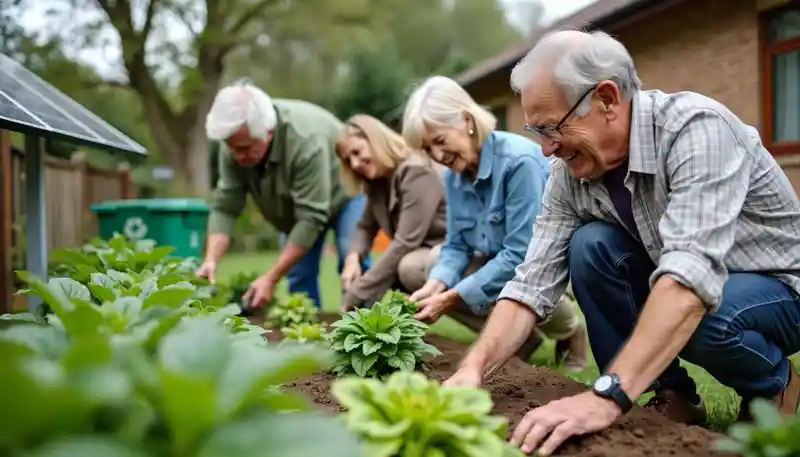Are you worried about your retirement savings and the environment? Green retirement communities offer a solution to both concerns. These eco-friendly living spaces help seniors save money while reducing their carbon footprint.
You’ll learn how these communities work and the benefits they provide. Ready to discover a sustainable retirement option?
Key Takeaways
- Green retirement communities help seniors save money and reduce their carbon footprint through energy-efficient buildings, waste reduction programs, and sustainable living practices.
- LEED-certified buildings in these communities use 25% less energy, 11% less water, and produce 34% lower CO2 emissions than standard buildings, leading to significant utility cost savings for residents.
- Seniors can access various financial incentives, including federal tax credits, state and local programs, and utility company rebates, to make sustainable living more affordable.
- By reducing food waste and using eco-friendly practices, residents can lower their household’s carbon footprint by up to 51,000 pounds annually and save about $1,400 per year.
- Green retirement communities enhance local biodiversity by creating urban green spaces that serve as habitats for plants and animals, while also improving air quality and managing water runoff.
Key Features of Green Retirement Communities

Green retirement communities offer unique features that help seniors live eco-friendly lives. These communities blend comfort with sustainability, creating spaces that are good for both residents and the planet.
Energy-efficient buildings
Energy-efficient buildings form the backbone of green retirement communities. These structures use smart design and cutting-edge tech to slash energy use. LEED-certified buildings consume 25% less energy than standard ones.
They also use 11% less water and produce 34% lower CO2 emissions. This means big savings on utility bills for seniors.
These eco-friendly homes don’t just save money. They boost health too. A Harvard study found that people living in green buildings scored 61% higher on cognitive tests. Better air quality and natural light play a key role in this improvement.
The next key feature of green retirement communities is their focus on waste reduction programs.
Waste reduction programs
Green retirement communities take waste reduction seriously. You’ll find smart programs that cut down on food waste, a big problem in the U.S. The U.S. Department of Agriculture reports that 30-40% of our food supply goes to waste each year.
By joining these efforts, you can save money and help the planet. Research from William & Mary shows that reducing food waste can save you about $1,400 annually.
These communities often use composting systems and teach residents how to cut down on waste. You’ll learn tips like using beeswax wraps instead of plastic wrap and buying only what you need.
The EPA says these steps can shrink your carbon footprint by 51,000 pounds yearly. Plus, you’ll help keep harmful methane gas out of landfills. The World Wildlife Fund warns that methane from food waste is worse for the climate than carbon dioxide.
Financial Benefits for Seniors
Green retirement communities offer big savings for seniors. You can cut your bills and boost your savings with eco-friendly living.
Lower utility costs
Green retirement communities offer big savings on utility bills. You’ll see lower costs for electricity, water, and heating. LEED-certified buildings use 25% less energy and 11% less water than standard ones.
This means more money stays in your pocket each month. For seniors on fixed incomes, these savings make a real difference.
Energy-efficient features like LED bulbs can save you up to $225 a year. Better insulation and smart thermostats cut heating and cooling costs too. Some communities even use solar panels to generate their own power.
All these eco-friendly choices add up to major savings for you. Next, let’s look at how sustainable living grants can boost your budget even more.
Sustainable living grants and incentives
You can save money and help the planet in green retirement communities. Many grants and incentives make sustainable living more affordable for seniors.
- Federal tax credits: You can get up to $1.80 per square foot in tax deductions for energy-efficient upgrades. This applies if you cut energy use by 50% or more.
- State and local programs: Many areas offer rebates or low-interest loans for green home improvements. Check with your city or state for available options.
- ENERGY STAR benefits: Communities like Brookdale Senior Living save big through the EPA’s ENERGY STAR program. You could see lower utility bills in these certified buildings.
- LEED certification perks: Places like Hilltop Reserve in Denver gain advantages from LEED Gold status. This often means better air quality and lower operating costs for residents.
- Utility company incentives: Your local power company may offer cash back for using energy-efficient appliances or solar panels. Ask about their green energy programs.
- Nonprofit grants: Some organizations give money to seniors for eco-friendly home updates. Research groups in your area that support sustainable aging.
- Community solar projects: You might get discounted clean energy by joining a shared solar program. This lets you use renewable power without installing panels yourself.
FAQs
1. What are green retirement communities?
Green retirement communities are living spaces for seniors that follow eco-friendly practices. They use sustainable building methods, reduce energy use, and promote earth-friendly habits among residents.
2. How do these communities help seniors save money?
These communities cut costs through energy-saving measures like solar panels and better insulation. They also encourage shared rides and use of public transit, which lowers transport costs for seniors.
3. What role does LEED play in green retirement communities?
LEED, or Leadership in Energy and Environmental Design, sets standards for green building. Many retirement communities aim for LEED certification to show their commitment to reducing their impact on the environment.
4. How do seniors in these communities fight climate change?
Seniors take part in recycling programs, use less single-use items, and choose eco-friendly products. Some even engage in retirement activism, sharing inspiring stories on social media to promote sustainable living.
5. What are some features of green retirement buildings?
Green retirement buildings often have rooftop gardens, use green building materials, and have systems to reduce water and energy use. They may also have features like passive housing design to maintain comfort with less energy.
6. How do these communities address both environmental and social needs?
Besides being eco-friendly, these communities focus on social connectivity. They often have mixed-use spaces that allow seniors to interact, reducing loneliness while living a sustainable lifestyle.
References
- https://icecobotics.com/blog/why-green-senior-living-is-growing-in-popularity-
- https://mylifesite.net/blog/post/green-retirement-communities-benefit-environment-business-health/ (2023-09-11)
- https://www.plasticbusters.org/resources/microplastics-and-un-sdg-268we (2023-12-28)
- https://theridgeseniorliving.com/blog/green-retirement-communities/
- https://2lifeopus.org/blog/going-green-in-retirement/
- https://www.ncbi.nlm.nih.gov/pmc/articles/PMC9653953/
- https://moretimemoms.com/lifestyle/environmental-sustainability-in-senior-retirement-communities/






